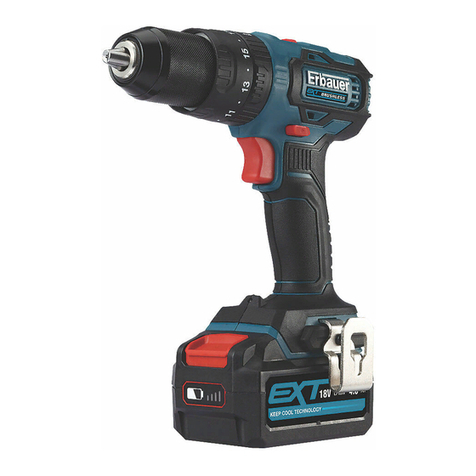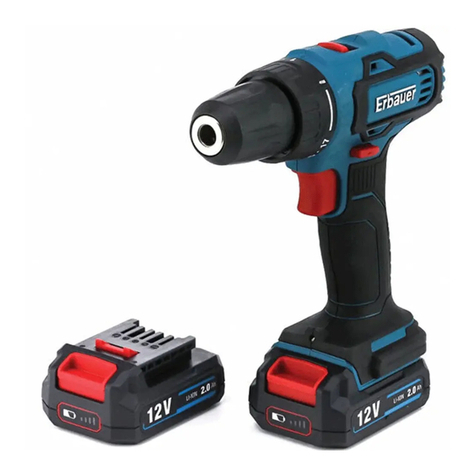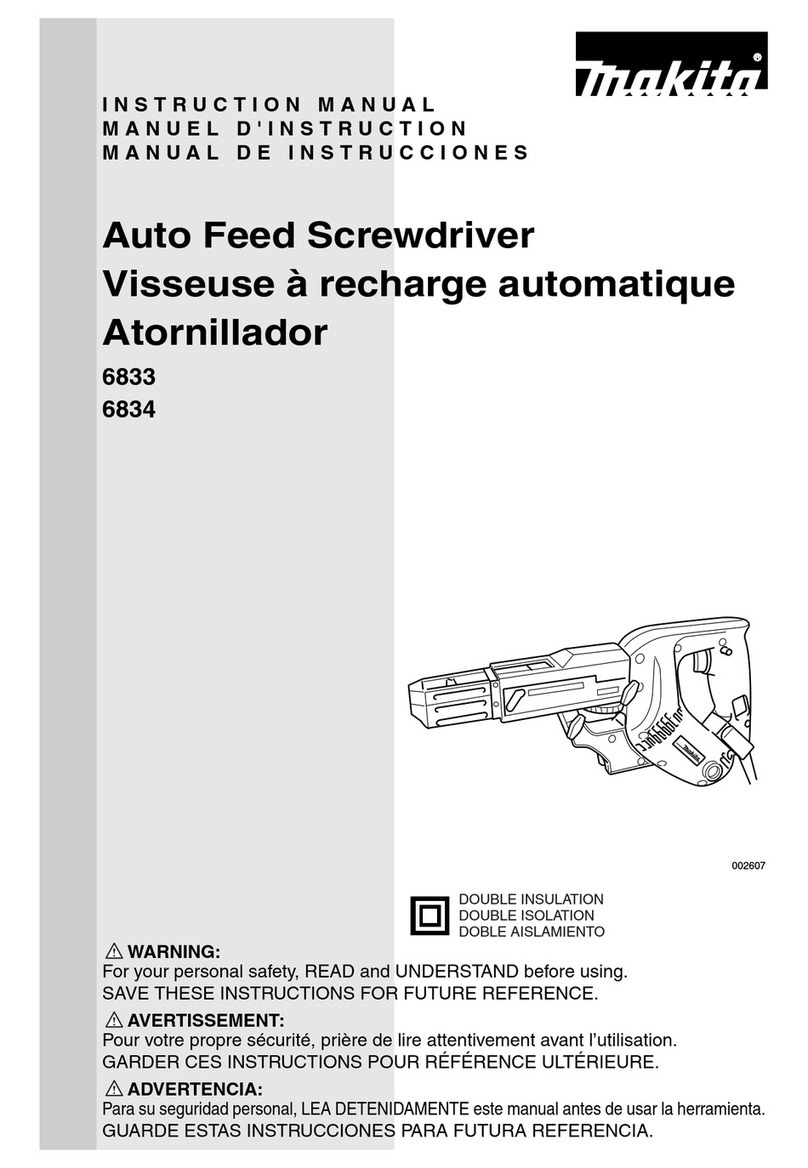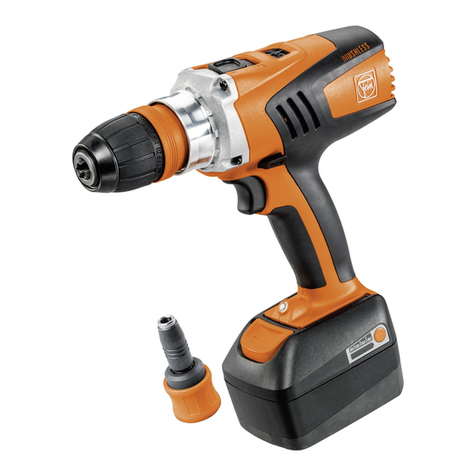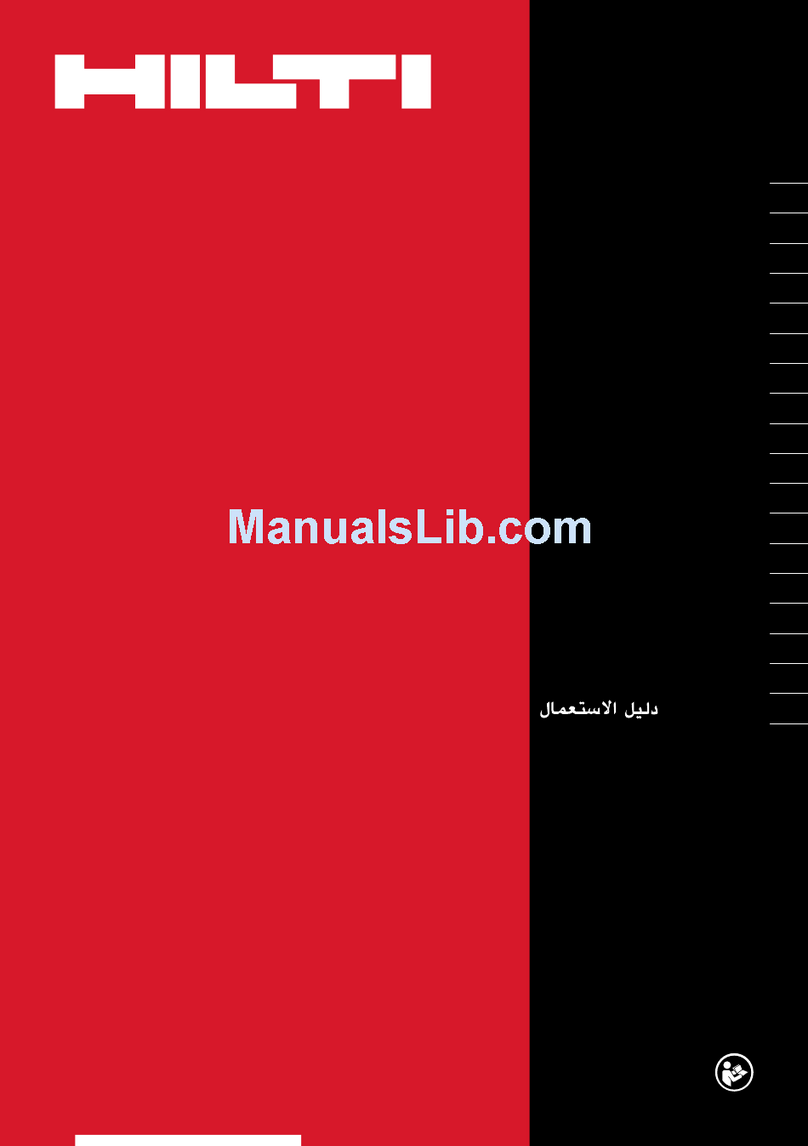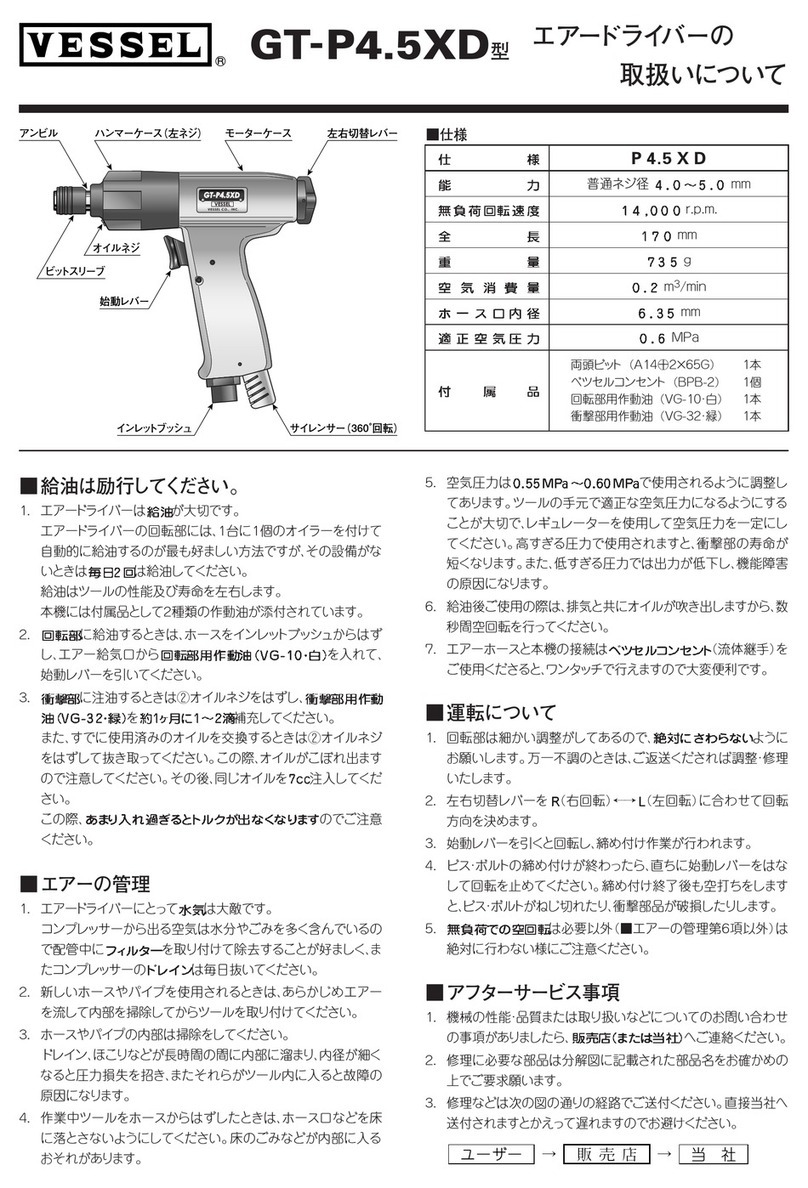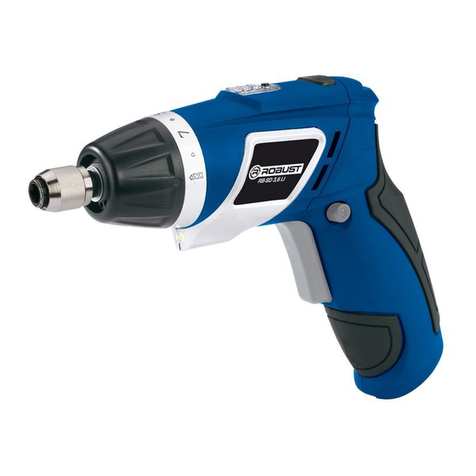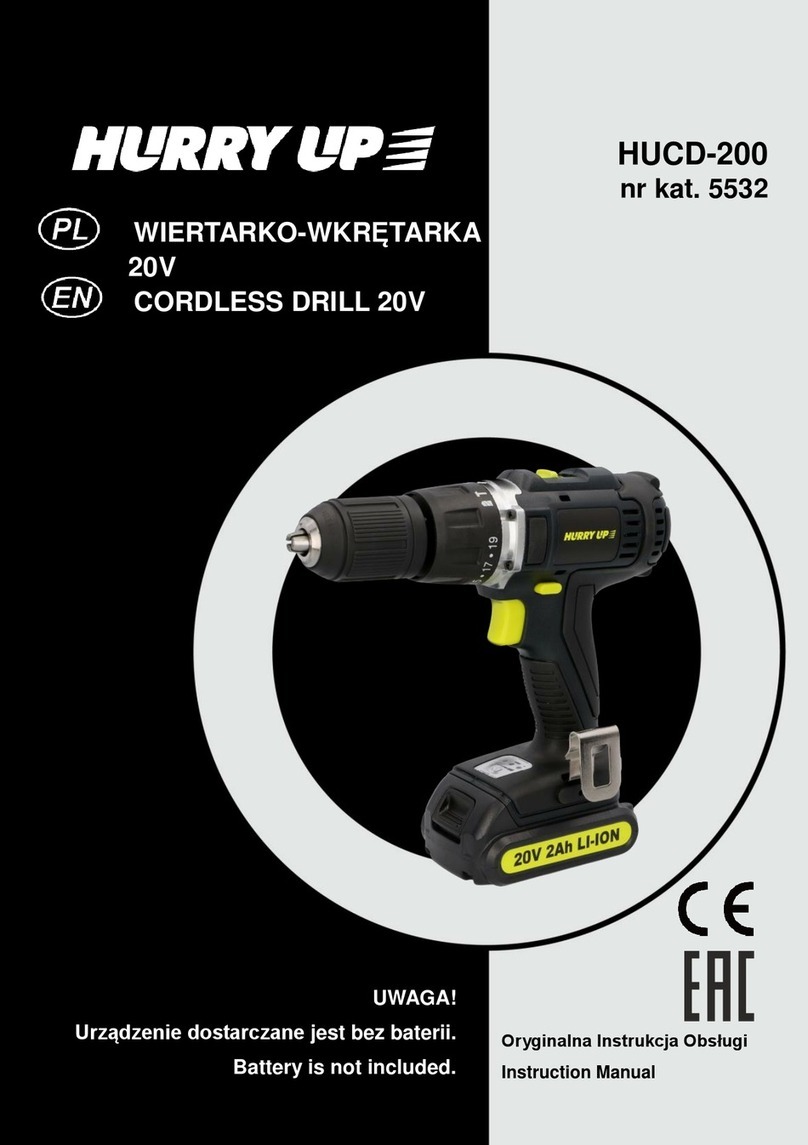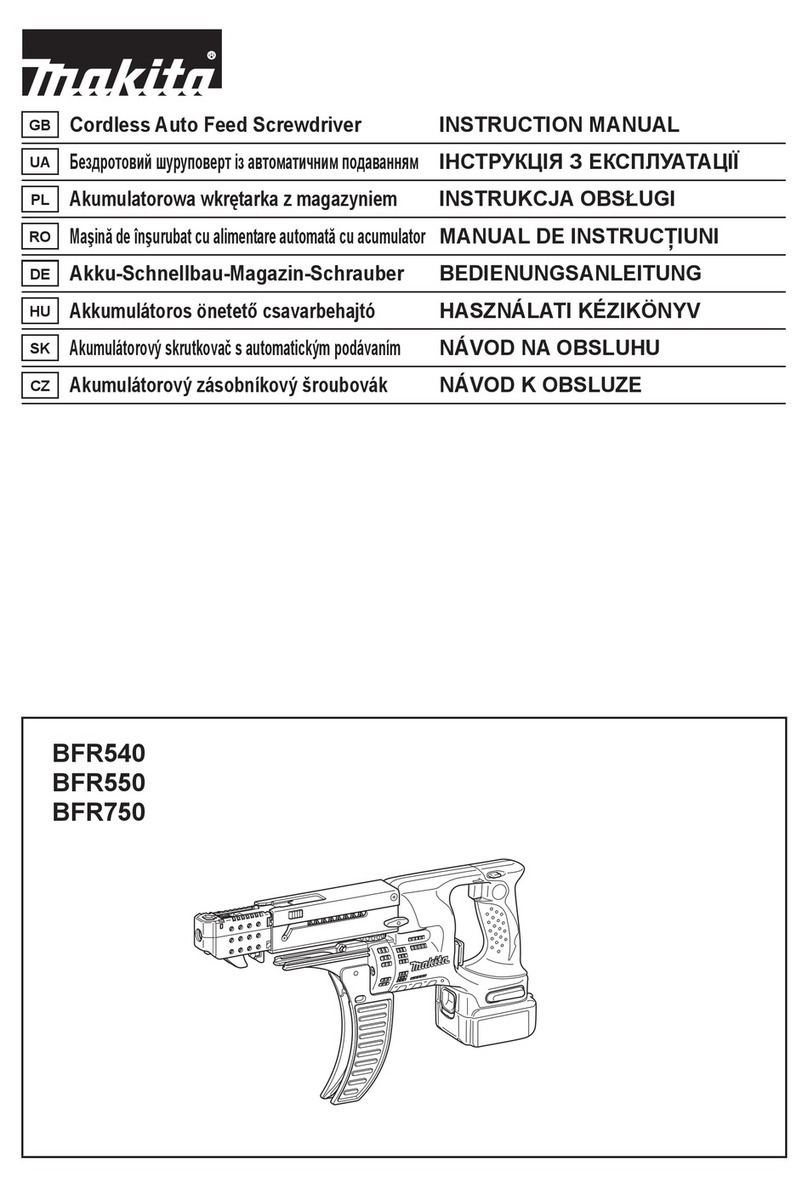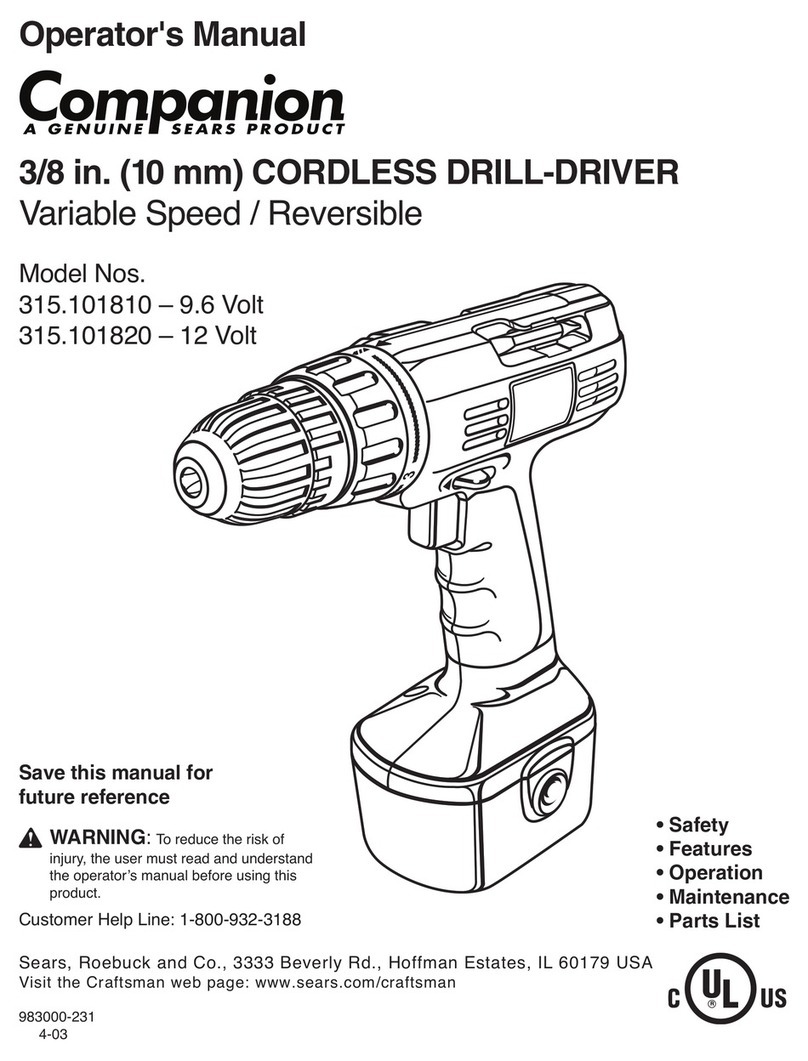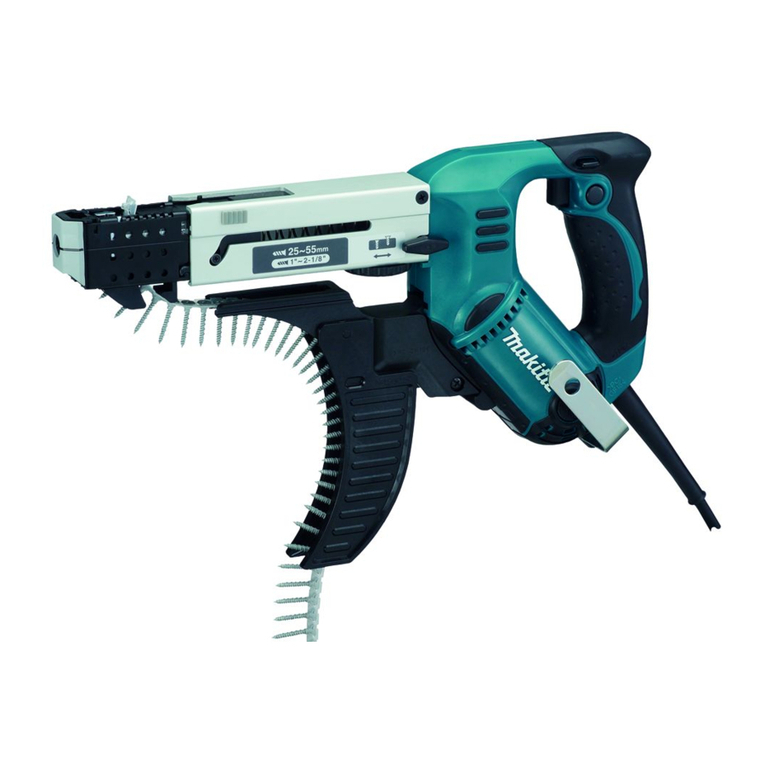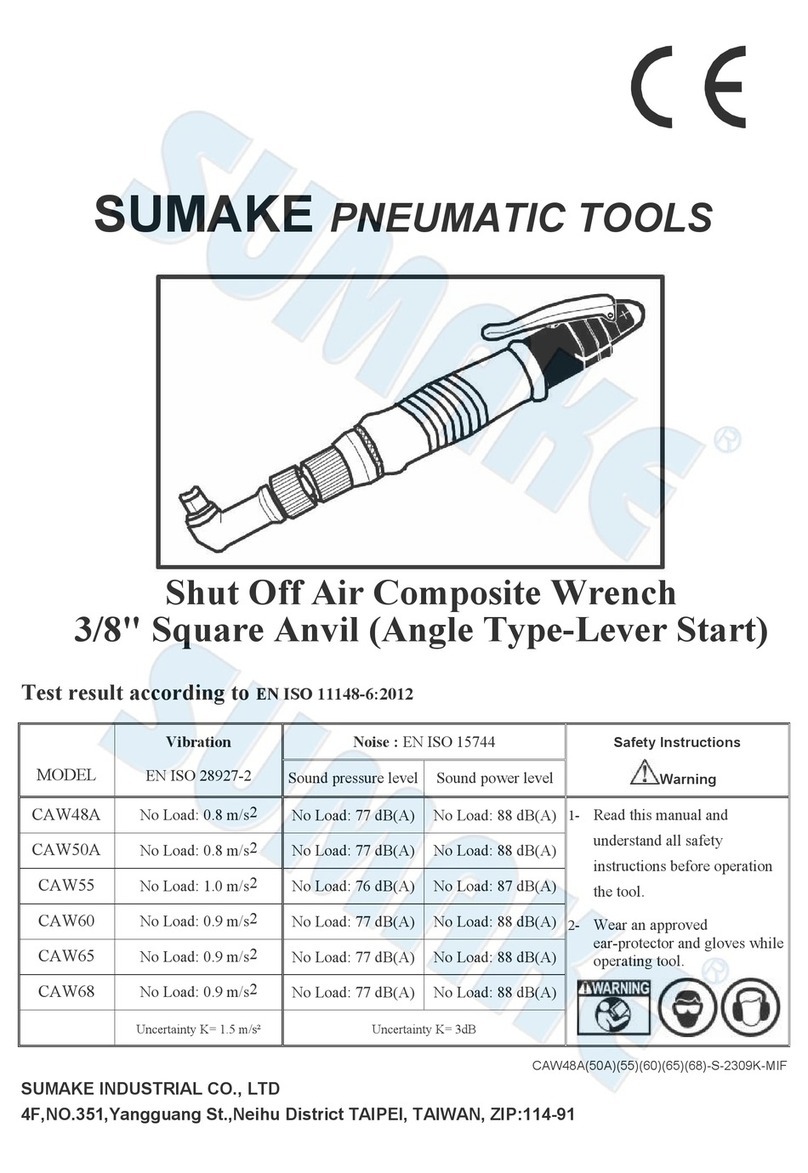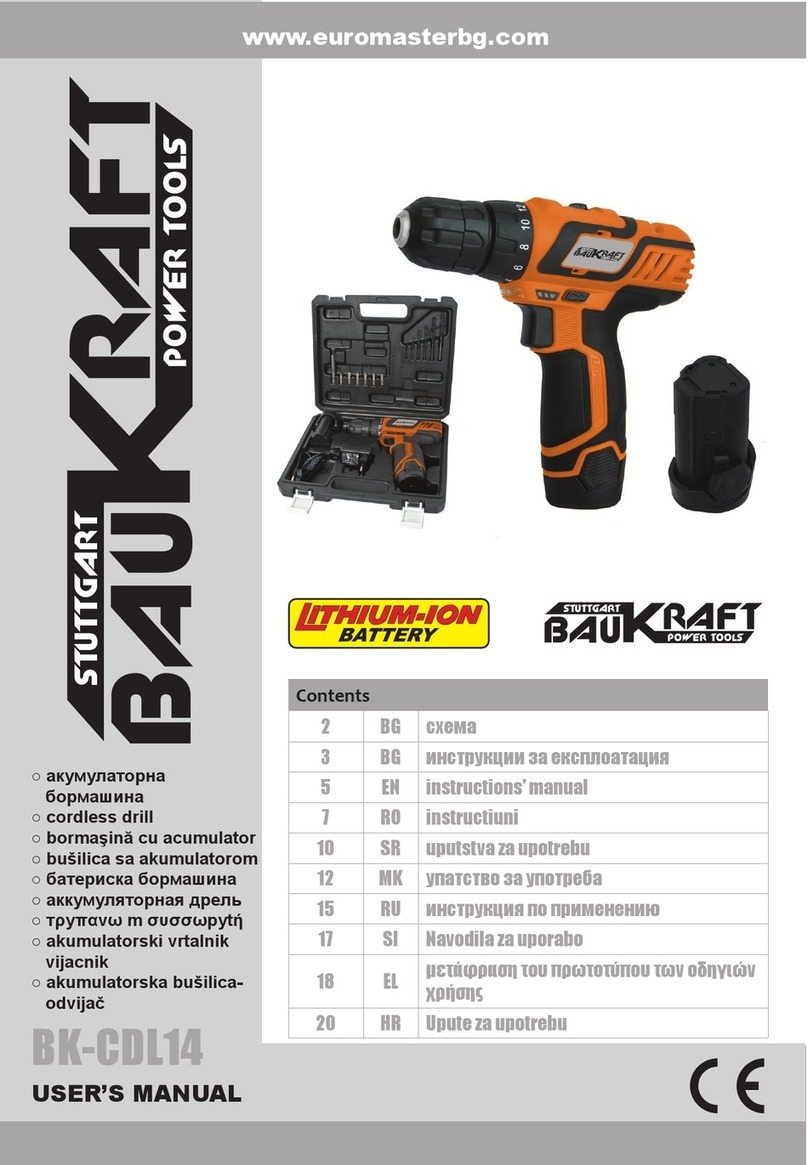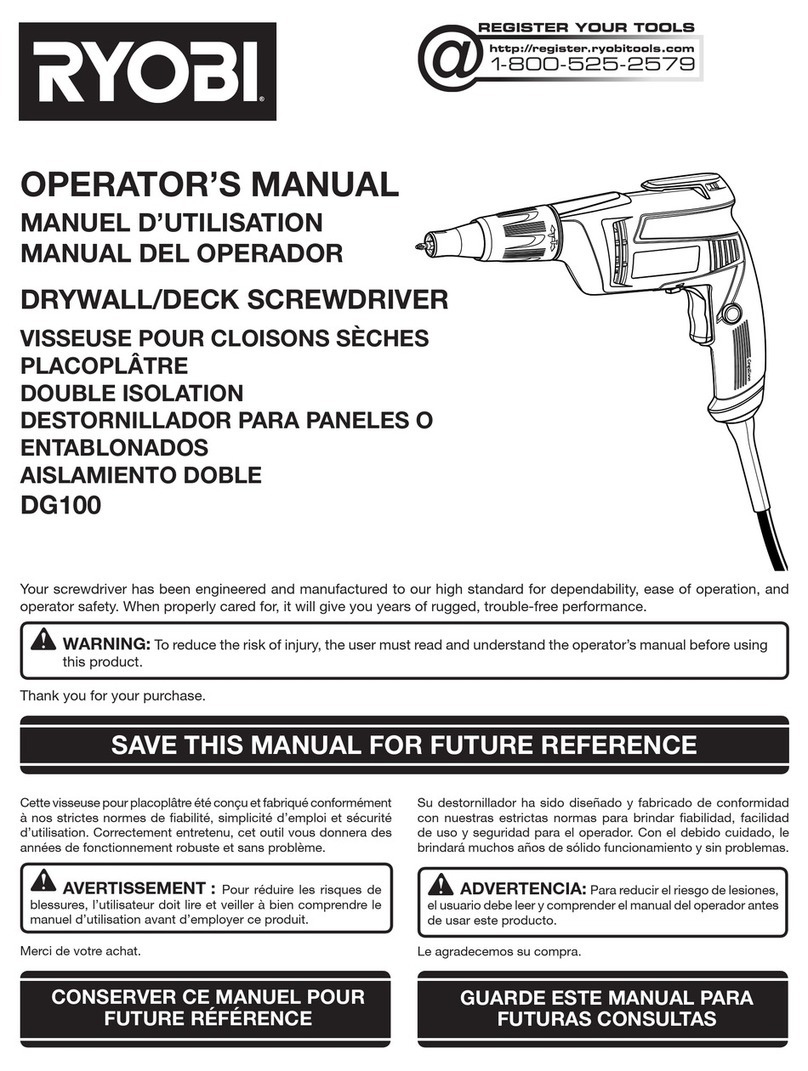Erbauer ECDT18-Li-2 User manual

MNL_ECDT18-Li-2_V03_BX220IM_200825
ECDT18-Li-2
EAN. 3663602440154
ORIGINAL INSTRUCTIONS

2
Safety instructions
Product description
Assembly
Use
Care & maintenance
Guarantee
Declaration of Conformity

3
WARNING! Please read all safety warnings carefully and be sure
that they are fully understood before handling the tool.
x1

4
PRODUCT DESCRIPTION
2 3 4
5
9
8
7
6
10
1a
1b
1
11
12
13
A1
2
1
A2

5
B1 B2
C D
E1 E2
E3 F

6
G H
I J
K

7
SAFETY INSTRUCTIONS
GENERAL POWER TOOL SAFETY WARNINGS
WARNING! Read all safety warnings, instructions,
illustrations and specications provided with this
power tool. Failure to follow all instructions listed below
may result in electric shock, re and/or serious injury.
Save all warnings and instructions for future
reference. The term “power tool” in the warnings refers
to your mains-operated (corded) power tool or battery
operated (cordless) power tool.”
WORK AREA SAFETY
a. Keep work area clean and well lit. Cluttered or dark areas
invite accidents.
b. Do not operate power tools in explosive atmospheres,
such as in the presence of ammable liquids, gases or dust.
Power tools create sparks which may ignite the dust or fumes.
c. Keep children and bystanders away while operating a
power tool. Distractions can cause you to lose control.
ELECTRICAL SAFETY
a. Power tool plugs must match the outlet. Never modify the
plug in any way. Do not use any adapter plugs with earthed
(grounded) power tools. Unmodied plugs and matching
outlets will reduce risk of electric shock.
b. Avoid body contact with earthed or grounded surfaces,
such as pipes, radiators, ranges and refrigerators. There
is an increased risk of electric shock if your body is earthed or
grounded.

8
c. Do not expose power tools to rain or wet conditions. Water
entering a power tool will increase the risk of electric shock.
d. Do not abuse the cord. Never use the cord for carrying,
pulling or unplugging the power tool. Keep cord away
from heat, oil, sharp edges or moving parts.Damaged or
entangled cords increase the risk of electric shock.
e. When operating a power tool outdoors, use an
extension cord suitable for outdoor use. Use of a cord
suitable for outdoor use reduces the risk of electric shock.
f. If operating a power tool in a damp location is unavoidable,
use a residual current device (RCD) protected supply. Use
of an RCD reduces the risk of electric shock.
PERSONAL SAFETY
a. Stay alert, watch what you are doing and use common
sense when operating a power tool. Do not use a power tool
while you are tired or under the inuence of drugs, alcohol
or medication. A moment of inattention while operating power
tools may result in serious personal injury.
b. Use personal protective equipment. Always wear eye
protection. Protective equipment such as a dust mask, non-
skid safety shoes, hard hat, or hearing protection used for
appropriate conditions will reduce personal injuries.
c. Prevent unintentional starting. Ensure the switch is in the
off- position before connecting to power source and/or
battery pack, picking up or carrying the tool.Carrying power
tools with your nger on the switch or energising power tools
that have the switch on invites accidents.
d. Remove any adjusting key or wrench before turning the
power tool on. A wrench or a key left attached to a rotating
part of the power tool may result in personal injury.
e. Do not overreach. Keep proper footing and balance at
all times. This enables better control of the power tool in
unexpected situations.

9
f. Dress properly. Do not wear loose clothing or jewellery. Keep
your hair and clothing away from moving parts. Loose clothes,
jewellery or longhair can be caught in moving parts.
g. If
devices are provided for the connection of dust
extraction and collection facilities, ensure these are
connected and properly used. Use of dust collection can
reduce dust-related hazards.
h. Do not let familiarity gained from frequent use of tools
allow you to become complacent and ignore tool safety
principles. A careless action can cause severe injury within a
fraction of a second.
POWER TOOL USE AND CARE
a. Do not force the power tool. Use the correct power tool for
your application. The correct power tool will do the job better
and safer at the rate for which it was designed.
b. Do not use the power tool if the switch does not turn it
on and off. Any power tool that cannot be controlled with the
switch is dangerous and must be repaired.
c. Disconnect the plug from the power source and/or remove
the battery pack, if detachable, from the power tool before
making any adjustments, changing accessories, or storing
power tools. Such preventive safety measures reduce the risk
of starting the power tool accidentally.
d. Store idle power tools out of the reach of children and do
not allow persons unfamiliar with the power tool or these
instructions to operate the power tool. Power tools are
dangerous in the hands of untrained users.
e. Maintain power tools and accessories. Check for
misalignment or binding of moving parts, breakage of
parts and any other condition that may affect the power
tools operation. If damaged, have the power tool repaired
before use. Many accidents are caused by poorly maintained
power tools.

10
f. Keep cutting tools sharp and clean. Properly maintained
cutting tools with sharp cutting edges are less likely to bind and
are easier to control
g. Use the power tool, accessories and tool bits etc. in
accordance with these instructions, taking into account
the working conditions and the work to be performed. Use
of the power tool for operations different from those intended
could result in a hazardous situation.
h. Keep handles and grasping surfaces dry, clean and free
from oil and grease. Slippery handles and grasping surfaces
do not allow for safe handling and control of the tool in
unexpected situations.
BATTERY TOOL USE AND CARE
a. Recharge only with the charger specied by the manufacturer.
A charger that is suitable for one type of battery pack may create a
risk of re when used with another battery pack.
b. Use power tools only with specically designated battery
packs. Use of any other battery packs may create a risk of
injury and re.
c. When battery pack is not in use, keep it away from other
metal objects, like paper clips, coins, keys, nails, screws
or other small metal objects, that can make a connection
from one terminal to another. Shorting the battery terminals
together may cause burns or a re.
d. Under abusive conditions, liquid may be ejected from the
battery; avoid contact. If contact accidentally occurs,
ush with water. If liquid contacts eyes, additionally seek
medical help. Liquid ejected from the battery may cause
irritation or burns.
e. Do
not use battery pack or tool that is damaged or
modied. Damaged or modied batteries may exhibit
unpredictable behaviour resulting in re, explosion or risk of
injury.

11
f. Do not expose a battery pack or tool to re or excessive
temperature. Exposure to re or temperature above 130 °C
may cause explosion.
g. Follow all charging instructions and do not charge the
battery pack or tool outside the temperature range
specied in the instructions. Charging improperly or at
temperatures outside the specied range may damage the
battery and increase the risk of re.
SERVICE
a. Have your power tool serviced by a qualied repair person
using only identical replacement parts. This will ensure that
the safety of the power tool is maintained.
b. Never service damaged battery packs. Service of battery
packs should only be performed by the manufacturer or
authorized service providers.
ADDITIONAL SAFETY WARNINGS FOR YOUR COMBI DRILL
a. Wear ear protectors when use impact drilling. Exposure to noise
can cause hearing loss.
b. Use auxiliary handle(s), if supplied with the tool. Loss of control
can cause personal injury.
c. Brace the tool properly before use. This tool produces a high
output torque and without properly bracing the tool during
operation, loss of control may occur resulting in personal injury.
d. Hold power tool by insulated gripping surfaces, when
performing an operation where the cutting accessory/fastener
may contact hidden wiring. Cutting accessory/fastener
contacting a “live” wire may make exposed metal parts of the
power tool “live” and could give the operator an electric shock.
e. Always check walls, oors and ceilings for hidden power cables
and pipes.

12
SAFETY INSTRUCTIONS WHEN USING LONG DRILL BITS
a Never operate at higher speed than the maximum speed
rating of the drill bit. At higher speeds, the bit is likely
to bend if allowed to rotate freely without contacting the
workpiece,resulting in personal injury.
b Always start drilling at low speed and with the bit tip in
contact with the workpiece. At higher speeds, the bit is
likely to bend if allowed to rotate freely without contacting the
workpiece, resulting in personal injury.
c Apply pressure only in direct line with the bit and do not
apply excessive pressure. Bits can bend causing breakage or
loss of control, resulting in personal injury.
ADDITIONAL SAFETY WARNINGS FOR BATTERY
a. Do not connect the positive terminal and negative terminal of
the battery to each other with any metal object (such as wire).
b. Do not carry or store battery together with necklaces, hairpins
or other metal objects.
c. Do not pierce the battery with nails, strike the battery with a
hammer, step on the battery or otherwise subject it to strong
impacts or shocks.
d. Do not solder directly onto the battery.
e. Do not expose battery to water or salt water, or allow the
battery to get wet.
f. Do not disassemble or modify the battery.
g. Do not place the battery in or near re, on stoves or other
high temperature locations. Do not place the battery in direct
sunlight, or use or store the battery inside cars in hot weather.
h. Do not place the battery in microwave ovens, high-pressure
containers or on induction cookware.
i. If you intend to store a battery for a period without use then
store battery at room temperature (19°C to 25°C), charged
to about 30 – 50% of capacity. When storing for very long

13
periods boost charge the battery once per year to prevent over
discharge.
The following information applies to professional users only but is
good practice for all users:
ADDITIONAL SAFETY WARNING FOR CONSTRUCTION DUST
The updated Control of Substances Hazardous to Health
Regulations 1st October 2012 now also targets to reduce the
risks associated with silica, wood and gypsumdusts. Construction
workers are one of the at-risk groups within this because of the
dust that they breathe: silica dust is not just a nuisance; it is a real
risk to your lungs!
Silica is a natural mineral present in large amounts in things like
sand, sandstone and granite. It is also commonly found in many
construction materials such as concrete and mortar. The silica is
broken into very ne dust (also known as Respirable Crystalline
Silica or RCS) during many common tasks such as cutting, drilling
and grinding. Breathing in very ne particles of crystalline silica
can lead to the development of: Lung cancer Silicosis Chronic
Obstructive Pulmonary Disorder/Chronic obstructive pulmonary
disease (COPD) And breathing in ne particles of wood dust can
lead to the development of Asthma. The risk of lung disease is
linked to people who regularly breathe construction dust over a
period of time, not on the odd occasion.
Toprotect the lung, the COSHH Regulations sets a limit on the
amount of these dusts that you can breathe (called a Workplace
Exposure Limit or WEL) when averaged over a normal working
day. These limits are not a large amount of dust: when compared
to a penny it is tiny – like a small pinch of salt: This limit is the legal
maximum; the most you can breathe after the right controls have
been used.
HOW TO REDUCE THE AMOUNT OF DUST?
1. Reduce the amount of cutting by using the best sizes of building

14
products. Use a less powerful tool e.g. a block cutter instead of
angle grinder.
2. Using a different method of work altogether – e.g. using a nail
gun to direct fasten cable trays instead of drilling holes rst.
3. Please always work with approved safety equipment, such
as those dust masks that specially designed to lter out
microscopic particles and use the dust extraction facility at all
time.
For more information please see the HSE website: http://www.hse.
gov.uk/construction or http://www.hse.gov.uk/pubns/cis69.pdf
WARNING! Some dust particles created by power
sanding, sawing, grinding, drill and other construction
jobs contain chemicals known to cause cancer, birth
defects or other reproductive harm. Some examples of
these chemicals are:
• Lead from lead-based paints.
• Crystalline silica from bricks and cement and other
masonry products.
• Arsenic and chromium from chemically treated timber.
• Your risk from these exposures varies, depending
upon how often you do this type of work. To reduce
your exposure to these chemicals:
• Work in a well-ventilated area.
• Work with approved safety equipment, such as
those dust masks that are specially designed to lter
microscopic particles
VIBRATION
The European Physical Agents (Vibration) Directive has been
brought in to help reduce hand arm vibration syndrome injuries to
power tool users. The directive requires power tool manufacturers

15
and suppliers to provide indicative vibration test results to enable
users to make informed decisions as to the period of time a power
tool can be used safely on a daily basis and the choice of tool.
SEE TECHNICAL SPECIFICATIONS IN THE INSTRUCTION
MANUAL FOR THE VIBRATION LEVELS OF YOUR TOOL.
The declared vibration emission value should be used as a
minimum level and should be used with the current guidance on
vibration.
Calculating the actual period of use can be difcult and the HSE
website has further information.
While working with this power tool, hand/arm vibrations occur.
Adopt the correct working practices in order to reduce the
exposure to vibration. This tool may cause hand-arm vibration
syndrome if its use is not adequately managed.
Helping to minimise your vibration exposure risk. ALWAYS use sharp
chisels, drills and blades. Maintain this tool in accordance with
these instructions and keep well lubricated (where appropriate).

16
Avoid using tools in temperatures of 10ºC or less. Plan your work
schedule to spread any high vibration tool use across a number of
days.
NOTE: The use of other tools will reduce the users’ total
working period on this tool.
HEALTH SURVEILLANCE
All employees should be part of an employer’s health surveillance
scheme to help identity any vibration related diseases at an early
stage, prevent disease progression and help employees stay in
work.
RESIDUAL RISKS
Even if you are operating this product in accordance with all
the safety requirements, potential risks of injury and damage
remain. The following dangers can arise in connection with
the structure and design of this product:
1. Injuries and damage to property due to broken attachments or
the sudden impact of hidden objects during use.
2. Danger of injury and property damage caused by ying objects
or poor power tool accessories.

17
PRODUCT DESCRIPTION
1. Keyless chuck
1a. Chuck jaws
1b. Chuck sleeve
2. Torque adjustment ring
3. Function selection ring
4. Two-speed gear control
5. Forward/reverse rotation control
6. Battery pack
7. Power bar button
8. Battery pack release button
9. LED work light
10. Belt clip
11. On/off switch
12. Handle
13. Auxiliary handle
01 TECHNICAL SPECIFICATIONS
Drill
Rated voltage: 18V d.c.
Rated no load speed: 0-550/0-2000/min
Impact rate: 0-8800/0-32000/min
Clutch position:
Max. torque:
24+1+1
120 N.m
Chuck capacity:
Max. drilling capacity:
13mm
•
Wood 35mm
•
Steel 13mm
•
Masonry 16mm
Weight(without battery): 1.8 kg
Battery
Battery pack model: EBAT18-Li-5
Battery voltage: 18V d.c.
Battery capacity: 5Ah

18
Battery cell: Li-Ion 3.6V x 10pcs
Weight: 0.7kg
For use with battery pack and charger as below:
Battery pack model: EBAT18-Li-2 / EBAT18-Li-4 / EBAT18-Li-5 / EHPB18-Li-4
EHPB18-Li-8
Charger model: EC18-Li / EFC18-Li / EMC18-Li
Ambient temperature range for tool and battery use: -10oC to 40oC
NOISE DATA
A weighted sound pressure: LpA=92.5dB(A)
A weighted sound power: LwA=103.5dB(A)
Uncertainty: KPA & KWA=3.0dB(A)
The noise for the operator may exceed 80 dB(A) and ear protection measures are
necessary.
VIBRATION DATA
Impact drilling into concrete: ah,ID= 11.0m/s²
Drilling into metal: ah,D= 1.6m/s²
Uncertainty K=1.5m/s2
The declared vibration total values and the declared noise emission values have
been measured in accordance with a standard test method(EN62841-1/EN62841-2-
1) and may be used for comparing one tool with another; they may also be used in a
preliminary assessment of exposure.
WARNING ! The vibration and noise emissions during actual use of the
power tool can differ from the declared values depending on the ways in
which the tool is used especially what kind of workpiece is processed; and
need to identify safety measures to protect the operator that are based on an
estimation of exposure in the actual conditions of use (taking account of all
parts of the operating cycle such as the times when the tool is switched off
and when it is running idle in addition to the trigger time).
RATING LABEL EXPLANATION
ECDT18-Li-2 = MODEL NUMBER E = ERBAUER
CD = COMBI DRILL
T = Trade use
18 = 18 V d.c.
Li = LITHIUM ION
2 = 2 SPEED

19
ASSEMBLY
01 SYMBOLS
Read the instruction manual
Wear eye protection
Wear hearing protection.
Wear a dust mask.
Do not dispose of battery packs in rivers or immerse in water.
Do not dispose of battery packs in re. They will explode and
cause injury.
Do not expose battery packs to heat in excess of 40°C
/ BL Brushless motor
Keep Cool Battery Technology
yyWxx Manufacturing date code: Year of manufacturing (20yy) and week
of manufacturing (Wxx)

20
02 UNPACKING
Unpack all parts and lay them on a at, stable surface.
• Remove all packing materials and shipping devices, ifapplicable.
• Make sure the delivery contents are complete and free of any damage. If you nd that parts
are missing or show damage do not use the product but contact your dealer. Using an
incomplete or damaged product represents a hazard to people and property.
• Ensure that you have all the accessories and tools needed for assembly and operation.This
also includes suitable personal protective equipment
WARNING! The product and the packaging are not children’s toys!
Children must not play with plastic bags, sheets and small parts! There is a
danger of choking and suffocation!
03 ASSEMBLING THE MACHINE
CHARGING YOUR BATTERY PACK
The battery has been shipped in a low charge condition. Charge it fully before rst use.
Refer to the charger instruction manual for the details.
TO REMOVE OR INSTALL THE BATTERY PACK (A1, A2)
Depress the battery pack release button to release and slide the battery pack out from
your tool. After recharge, slide it back into your tool. A simple push and slight pressure will
be sufcient.
Other manuals for ECDT18-Li-2
1
This manual suits for next models
1
Table of contents
Other Erbauer Power Screwdriver manuals
